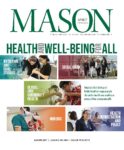Everyone has heard that you should conserve water by taking short showers and turning off the faucet when you brush your teeth. But did you know that you also conserve energy—electricity—by doing so?
According to Mason engineer Sharon deMonsabert, water usage consumes more energy than all other energy consumers, such as appliances, in the average household. The reason is that the water must first be pumped from the source to a water treatment facility, treated to drinking water standards, and then pumped to a residence or business. Finally, the wastewater must be pumped back to the facility for retreatment. All that pumping and treatment demands a huge amount of electricity.
“And yet, as we plan for facilities, we don’t take that energy usage into consideration,” points out deMonsabert, an associate professor of civil, environmental, and infrastructure engineering in the Volgenau School of Information Technology and Engineering.
DeMonsabert and others have reasoned that if water and wastewater treatment facilities were closer to users, then less pumping would be needed, and less electricity would be consumed. As communities grow, the location of treatment plants becomes significant.
“Typically, civil engineers tend to think that economies of scale are gained by just increasing the size of a treatment plant, but if we’re trying to be more sustainable, maybe a more distributed model is appropriate,” she says.
DeMonsabert and her PhD student Ali Bakhshi are working with the government of fast-growing Loudoun County, Virginia, to develop a geographical information system (GIS) model that will enable the county’s planners to aim for sustainable growth, minimizing the carbon footprint associated with water collection, treatment, distribution, and retreatment.
“We’ve had a lot of interest in that model,” says deMonsabert. A paper on the project they presented at a recent American Water Works Association conference drew a standing-room-only crowd. “It’s something of great concern to the water utility specialists. They know that they’re using a lot of energy, but it’s never been a focus before.”

Engineers may need to re-think the location of wastewater treatment plants in order to be more sustainable, deMonsabert's research suggests.
Another water project she worked on won deMonsabert and her graduate student Arjumand Zaidi the 2009 Best Practice-Oriented Paper Award from the American Society of Civil Engineers’ Journal of Water Resources Planning and Management. Their paper was based on research funded by the Commonwealth of Virginia for water quality modeling.
The research focused on total maximum daily load (TMDL), which specifies how much of a given pollutant, such as mercury or bacteria, a water body can absorb without becoming impaired. Streams determined to be impaired have a waste load allocation assigned to them, and producers of contaminants, such as agricultural enterprises, leaking wastewater treatment plants, or owners of leaking septic systems, are required to reduce the contaminants.
“What we found in running an additional model that coupled the implementation technologies—how you actually accomplish this reduction—was that it was infeasible.
It was a really big deal because every state is required under the Clean Water Act to implement TMDL programs to reduce the number of impaired streams. We showed that the way they were doing this was great, but that nobody could accomplish the bacterial objectives they were establishing with existing technologies. And we also showed that there were better ways to optimize—if you coupled allocation with implementation you could achieve better allocation.”
deMonsabert explains further that considering the large amount of money that goes into determining allocations, other ways to achieve the same objective, such as creating alternative swimming holes, should be considered.
“Take that million dollars that might be allocated to reducing the pollutant load and make a community swimming pool that people could actually enjoy,” she suggests.
deMonsabert, a registered professional engineer who owns her own engineering company, considers herself a water engineer, but she’s willing to tackle other areas related to sustainability when her students have a strong interest.
With her students Maria Pena and Richard Ross, deMonsabert has teamed with General Motors and Shell to expand the use of hydrogen-powered cars and buses. Hydrogen, deMonsabert points out, produces no emissions when generating energy in a fuel cell, and the only byproduct is water. Hydrogen is also relatively safe. In addition, cars driving on hydrogen get a whopping 300 miles per gallon. A Shell station providing hydrogen is located in nearby Washington, D.C.
To connect people with hydrogen-powered vehicles, deMonsabert and Reclamation Energy, a local developing green technology company, are investigating the use of social networking tools (Facebook, Twitter) and devices (PDAs, BlackBerrys, cell phones) in a rental car program that would be tied to Metro use. The project would introduce drivers to the vehicles and at the same time reduce carbon emissions.
“Students come in and they are passionate about their areas of research. And if I’m not an expert, it’s incumbent upon me to become an expert in the area they want to investigate,” says deMonsabert. “I do a lot of research in many different areas. But it’s fun for me because I like to learn and do different things.”
—Robin Herron


No Comments Yet »
Leave a comment